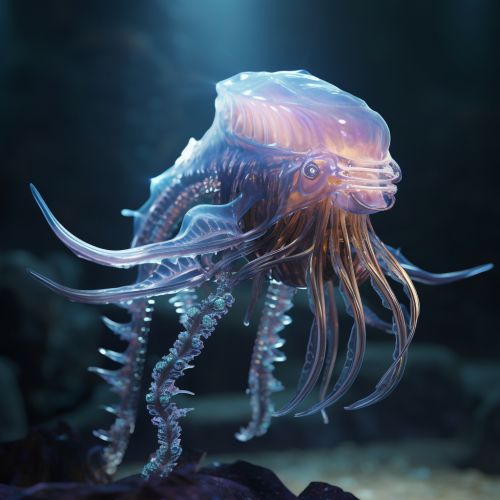Genetic Adaptations to High-Pressure Environments in Deep-Sea Fauna
Introduction
Deep-sea fauna are organisms that inhabit the deepest parts of the oceans, often under extreme conditions of high pressure, low temperatures, and complete darkness. These organisms have developed unique genetic adaptations that enable them to survive and thrive in these harsh environments. This article delves into the various genetic adaptations that these organisms have developed to withstand high-pressure environments.


Pressure Adaptations in Deep-Sea Fauna
The deep sea is characterized by high hydrostatic pressure, which increases by approximately 1 atmosphere (atm) for every 10 meters of water depth. This means that deep-sea organisms can experience pressures hundreds of times greater than those at sea level. To survive in such conditions, these organisms have developed a range of genetic adaptations.
Piezolytes
One of the primary adaptations is the production of piezolytes, small organic molecules that help to stabilize proteins under high pressure. These include trimethylamine N-oxide (TMAO), which is found in high concentrations in deep-sea fish and invertebrates. TMAO helps to counteract the destabilizing effects of pressure on proteins, enabling them to maintain their functional shapes even under extreme pressure.
Pressure-Regulated Genes
Deep-sea organisms also possess pressure-regulated genes, which are activated or deactivated in response to changes in hydrostatic pressure. These genes encode for proteins that are involved in a variety of cellular processes, including cell cycle regulation, DNA repair, and apoptosis. By modulating the expression of these genes, deep-sea organisms can adapt their cellular functions to cope with high-pressure environments.
Membrane Fluidity
High pressure can also affect the fluidity of cell membranes, making them more rigid and less permeable. To counteract this, deep-sea organisms have evolved to have higher levels of unsaturated fatty acids in their membranes, which help to maintain membrane fluidity under high pressure.
Evolution of High-Pressure Adaptations
The evolution of high-pressure adaptations in deep-sea fauna is a complex process that involves both genetic and environmental factors. It is thought that these adaptations have evolved over millions of years, as organisms colonized deeper and deeper parts of the ocean.
Genetic Drift
One of the main mechanisms driving the evolution of high-pressure adaptations is genetic drift. This is a process in which random changes in gene frequencies can lead to the fixation of beneficial mutations in a population. In the case of deep-sea organisms, mutations that confer resistance to high pressure would be selectively advantageous, and thus more likely to become fixed in the population.
Natural Selection
Natural selection also plays a key role in the evolution of high-pressure adaptations. Organisms that are better adapted to high-pressure environments are more likely to survive and reproduce, passing on their beneficial genes to the next generation. Over time, this can lead to the evolution of complex adaptations, such as the production of piezolytes and the regulation of pressure-sensitive genes.
Examples of High-Pressure Adaptations in Deep-Sea Fauna
There are many examples of deep-sea organisms that have evolved remarkable adaptations to high-pressure environments. These include both vertebrates and invertebrates, and range from microscopic organisms to large, complex animals.
Deep-Sea Fish
Deep-sea fish, such as the fangtooth, the grenadier, and the Anglerfish, have evolved a number of high-pressure adaptations. These include the production of high levels of TMAO, the regulation of pressure-sensitive genes, and the modification of cell membranes to maintain fluidity under high pressure.
Deep-Sea Invertebrates
Deep-sea invertebrates, such as giant tube worms, yeti crabs, and vampire squids, also have a range of high-pressure adaptations. These include the production of piezolytes, the regulation of pressure-regulated genes, and the modification of cell membranes.
Conclusion
The deep sea is one of the most extreme environments on Earth, and the organisms that inhabit it have evolved a range of remarkable genetic adaptations to survive under high pressure. These adaptations include the production of piezolytes, the regulation of pressure-sensitive genes, and the modification of cell membranes. Understanding these adaptations not only provides insights into the biology of deep-sea organisms, but also has potential applications in biotechnology and medicine.
